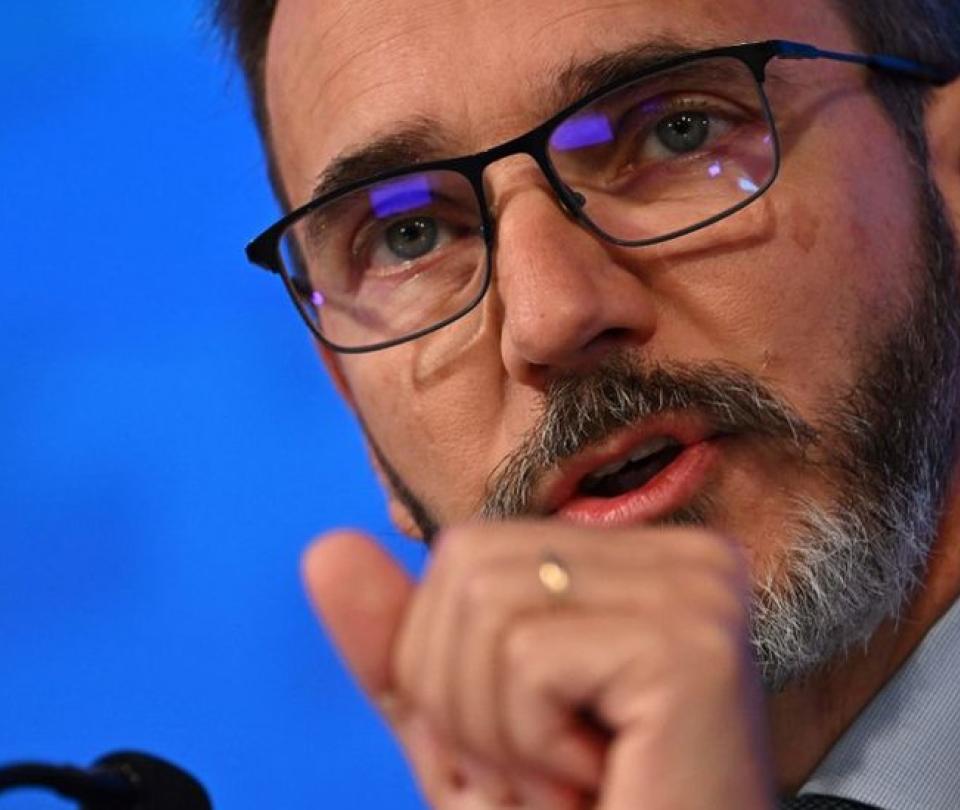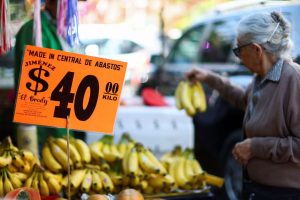Things are about to change for much of the Latin American economies.
If at the beginning of the year the rise in the prices of raw materials made it possible to offset the effects of inflation, the increase in interest rates is about to damage the good performance recorded at the beginning of the year.
At least that is what IMF economists believe.
“In the coming months, given the tightening of global financial conditions, the slowdown in the world economy and also some drop in the prices of raw materials, which we are already seeing, we expect a very significant slowdown in the region’s economy,” explains in this interview with BBC Mundo, Gustavo Adler, head of the Division in the Western Hemisphere Department of the International Monetary Fund (IMF).
However, each country will suffer the consequences of the global economic turmoil in a different way.
“In Mexico, after a strong first half in 2022, the economy is expected to slow down in late 2022 and early 2023, at the same time as the United States,” its main trading partner, says the report on the region presented this week.
In Bolivia, Colombia or Peru, the IMF believes that growth will moderate in the coming quarters.
The same as in Chile, but the government of Gabriel Borich faces “risks that stem from possible social discontent over high food and energy prices, unsatisfied social demands, or the uncertain outcome of the constitutional reform process.”
In Argentina, inflation does not seem to be giving up. Its internal problems coupled with policy uncertainty and a worsening external environment are worsening the outlook.
“The adoption of more restrictive policies under the IMF-backed program will be essential to underpin stability and contain inflation, which is now projected to rise to 95% by the end of 2022,” economists at the IMF-based organization say. Washington.
For their part, remittances, tourism and exports will play an important role in Central America.
In the case of El Salvador, says the IMF, “the fiscal situation remains critical, so fiscal consolidation must be the top priority.”
“It is necessary to address the risks arising from the adoption of bitcoin as legal tender,” says the institution, referring to one of the most striking (and controversial) economic measures in the entire region.
We spoke with Gustavo Adler, an economist at the IMF, to analyze what Latin America can expect in the coming months.
In a post on the IMF blog, several economists spoke of Latin America facing a third shock due to rate hikes by central banks. What were the two previous shocks that the region suffered? What is this third shock that is coming for you?
In the last 3 years, the Latin American and Caribbean region faced two very important shocks. The first, of course, the pandemic.
In 2020 and 2021, the pandemic clearly dominated the entire economic outlook of the region and had very severe consequences throughout Latin America and the Caribbean.
Towards the end of 2021 and the beginning of this year, we were finally seeing a normalization of economic activity.
Now, at the beginning of this year, despite also having inflationary pressures, came the second shock, which was the Russian invasion of Ukraine.
Basically, it implied a very strong rise in the price of commodities for Latin America. Now, some of the countries in the region are exporters of raw materials and they benefited from that.
What we are seeing now, more recently, is the third shock, which is the tightening of global financial conditions.
What is this rise in interest rates going to cause in Latin America in the world’s main economies?
The tightening of monetary policy by central banks, mainly in the United States and Europe, is making external financing more expensive, but it is also causing international investors to flee.
We are coming out of a long period of low interest rates in which there was a search for higher yields that greatly favored emerging markets. Several of them are in the region.
Now we’re seeing a reversal of that, where capital is basically going back to safer assets, like the dollar.
What happens to an economy when financing becomes “increasingly scarce and increasingly expensive”?
It means that the possibilities of taking credit in the economy are less and more expensive. Making investments becomes more expensive and therefore there is a tendency to see a slowdown in private investment.
In the same way, taking credit for consumption becomes more expensive and then there is a slowdown in consumption as well.
This obviously translates into a lower boost to the economy’s domestic demand and to economic activity.
In turn, there is an effect on public accounts. The public sector has to pay higher interest on its debt.
Is there any effect on the currency?
Yes. What there is in general is an outflow of capital from the economy that tends to put pressure on the exchange rate and weaken local currencies.
And we have already seen that in part with the strengthening of the dollar.
This can have contractionary effects on the economy to the extent that households or companies -and this happens in many Latin American countries- are indebted in foreign currency.
In that case, when the local currency weakens, that debt in foreign currency becomes more difficult to pay and therefore also has contractionary effects on investment and consumption decisions.
In this context of inflation, global slowdown and rate hikes in the world’s main economies, what awaits Latin America at the end of the year and the next?
It is important to put Latin America in context before the third shock.
The region had fairly good growth and a steady pace as part of its recovery from the pandemic thanks to the reopening of the service sectors at the beginning of the year, the recovery of employment and private consumption.
To this was added the increase in the prices of raw materials, which despite the first increases in interest rates by the Fed, strengthened the growth of the Latin American economies.
Especially from South America, which are the main exporters of commodities.
In fact, that made economic activity very strong in the first half especially, and led us to raise our projections for 2022.
Right now, at the IMF, we believe that the region as a whole is going to grow 3.5% this year, which is half a percentage point more than what we forecast in July.
And what can we expect regarding inflation?
Inflationary pressures were also, at the same time, stronger due to the push of domestic demand and the high prices of raw materials.
And that also led us to raise our inflation projections for the region, which are now projected at 14.6% by the end of this year.
Going forward, with the tightening of global financial conditions, the slowdown in the world economy and also some drop in raw material prices, which we are already seeing, we expect a very significant slowdown in the region’s economy.
And that is seen in all the countries of the region, both in South America and in Central America and the Caribbean.
And in that sense we expect that growth for the year 2023 will be around 1.7%, which is basically half of what we expect for this year.
At the same time, we are expecting inflation to still remain relatively high.
It will start to decline in relation to the levels we are experiencing this year, but it will continue to be relatively high and we expect it to basically end 2023 around 9-10% compared to December of the previous year.
So we see a context in which the economies of Latin America are going to slow down, while inflation is going to remain high, gradually declining, but it is going to remain high.
Which countries are better prepared and what factors make them better prepared?
Historically, the region has been very sensitive to monetary policy conditions in the United States.
A Fed rate hike was normally associated with rate hikes in the region and with capital outflows and quite significant effects on economic activity itself.
Now, not all countries are equally vulnerable to this effect and it depends a bit on economic fundamentals, which are very important to mitigate or amplify these effects.
One of the keys is the level of international reserves.
The higher, the more the consequences can be cushioned.
And in this sense, the region has improved a lot when one compares it with respect to past episodes of monetary policy tightening in the United States.
If you look back in the 1980s, for example, or in the early 2000s, and compare with today’s reserve levels, in most countries in the region they are much higher.
That is an additional level of strength that countries have today compared to the past.
Another relevant aspect is the financing needs, especially in foreign currency, which vary from one country to another, and the soundness of the financial system.
The banking system in general is very strong compared to the past and is not a source of concern. There are very solid liquidity and capital ratios.
And of course, there has already been a very important improvement when it comes to banking supervision and regulation in the last two decades.
And if we talk about countries?
Well, I would tell you from the point of view, for example, of the fundamentals of public debt, that there are countries like Chile, Peru or Paraguay, which have very low levels of public debt and are clearly in a good position to face this type of impact.
Other countries look less robust, but may be in other dimensions like reserve levels, for example. There is no single measure.
The five big countries of Latin America, Brazil, Chile, Colombia, Mexico, and Peru have a very solid banking system today in relation to the past.
But perhaps it is important to emphasize that the region depends not only on the tightening of global financial conditions, but also on other factors. And there is indeed a difference between subregions.
For example, South America is a region that exports raw materials and will depend a lot on what happens with prices in international markets, especially grains and metals.
We have already seen prices drop significantly and we expect them to continue to decline.
Central America, on the other hand, is very tied to the US economy, both in terms of exports and remittances, and that very much depends on what happens with the US labor market.
And in this context, what are the main risks?
From the external point of view, I would say that there are two and they are and are related. One is that world inflation is more persistent than expected.
That there is a entrenchment of this high inflation, especially in advanced economies. That would mean that the central banks of the main economies will probably have to make monetary policy much more contractionary than expected.
And this would make the tightening of global financial conditions even more exacerbated. That would obviously slow down the region’s economy even more.
Of course, the other risk, somewhat independent, but with probably related effects, would be an escalation in the geopolitical conflicts that we are seeing.
Now you can receive notifications from BBC World. Download the new version of our app and activate it so you don’t miss out on our best content.






![[Img #74675]](https://thelatestnews.world/wp-content/uploads/2024/12/They-discover-a-new-class-of-X-ray-sources-in-the-150x150.jpg)







